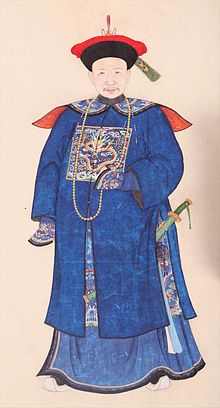
Back خو شين Arabic خو شين ARZ Хэшэнь Byelorussian Heshen Catalan Huò-sĭng CDO Che-šen Czech Heshen German Heshen Spanish Heshen French השן, המשנה לקיסר סין HE
This article needs additional citations for verification. (November 2012) |
Heshen | |
|---|---|
 | |
| Chief Grand Councillor | |
| In office 1797–1799 | |
| Monarch | Jiaqing Emperor |
| Preceded by | Agui |
| Succeeded by | Yongxing |
| Grand Councillor | |
| In office 1776 – 1799 (as the Chief Grand Councillor since 1797) | |
| Monarchs | Qianlong Emperor Jiaqing Emperor |
| Grand Secretary of the Wenhua Hall | |
| In office 11 September 1786 – 2 February 1799 | |
| Monarchs | Qianlong Emperor Jiaqing Emperor |
| Preceded by | Cai Xin |
| Succeeded by | Dong Gao |
| Minister of Personnel | |
| In office 4 September 1784 – 16 September 1786 Serving with Liu Yong | |
| Monarch | Qianlong Emperor |
| Preceded by | Umitai |
| Succeeded by | Fuk'anggan |
| Minister of Revenue | |
| In office 26 April 1780 – 4 September 1784 Serving with Liang Guozhi | |
| Monarch | Qianlong Emperor |
| Preceded by | Feng Yinglian |
| Succeeded by | Fuk'anggan |
| Personal details | |
| Born | Shanbao (善保) 1 July 1750 Beijing, Qing Empire |
| Died | 22 February 1799 (aged 48) Zhizhai, Beijing, Qing Empire |
| Cause of death | Forced suicide by hanging |
| Spouse | Feng Jiwen |
| Domestic partner | Lady Chang |
| Relations | Gurun Princess Hexiao (daughter-in-law) Helin (brother) |
| Children | Fengšeninde 1 son 3 daughters |
| Occupation | Official |
| Noble titles | 1st class baron→3rd class earl→1st class duke |
Heshen (Manchu: ᡥᡝᡧᡝᠨ, Möllendorff: Hešen; Chinese: 和珅; pinyin: Héshēn; Wade–Giles: Ho2-shen1; 1 July 1750 – 22 February 1799) of the Manchu Niohuru clan, was an official of the Qing dynasty favored by the Qianlong Emperor and called the most corrupt official in Chinese history. After the death of Qianlong, the Jiaqing Emperor confiscated Heshen's wealth and forced him to commit suicide. As an official, he acquired an estimated at 1.1 billion taels of silver, equal to roughly US$270 billion. Heshen is remembered as one of the richest men in history.
Born Shanbao (Shan-pao; 善保), his name was later changed to Heshen. His courtesy name was Zhizhai (Chih-chai; 致齋). He was a member of the Plain Red Banner.